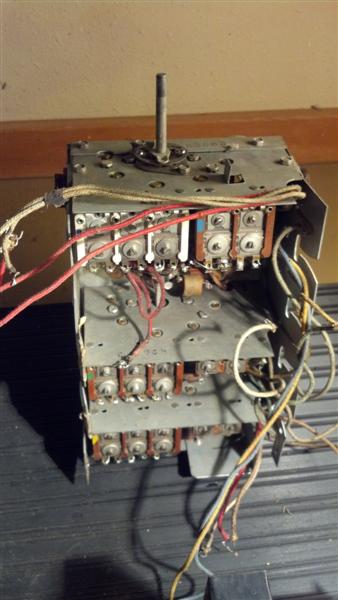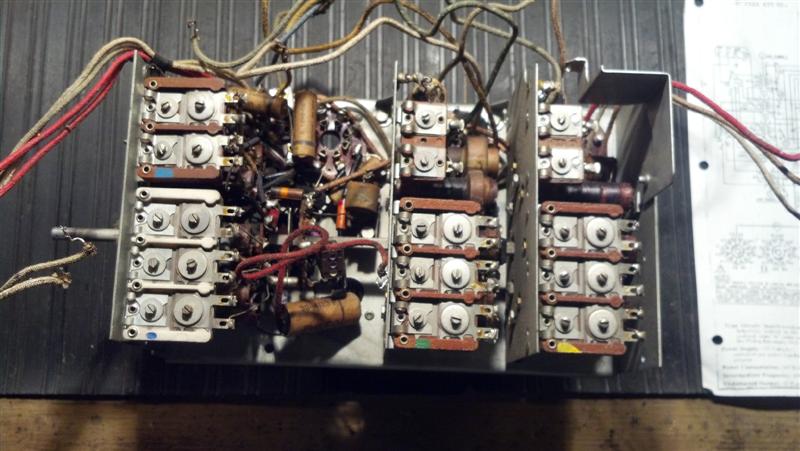Posts: 661
Threads: 141
Joined: Jun 2011
City: Elko,MN.
Well, here we go again,
I am tired of looking at the schematics on the 38-116 I have been playing with.
I replaced all of the caps other than a couple that are buried in the sub-chassis.
I found a coil buried in the center section that has a very fine hair like wire that I mistakenly broke, and attempted to re-solder.
The radio worked again after re-soldering that very fine wire.( I think I got it).
But after replacing the caps and some resistors, have not been able to get the radio working as it should.
I don't know if I missed something or screwed something up.
This one is probably a little over my head.
Would like to find someone local that could check it out and finish it for me without spending a small fortune.
Any suggestions?
murf
Posts: 49
Threads: 8
Joined: Nov 2008
City: Baton Rouge, LA
I recently restored a 38-116. According to my notes I checked 12 resistors and 6 paper caps in the sub chassis. All paper caps failed leak test at a 10V load. I suspect your problem results from paper caps that have not been replaced.I replaced all paper caps and 3 sub-chassis out of spec resistors. But now I regret not replacing the mica caps in the sub-section. If one fails the sub-section will have to be pulled again. Recommend replacing those micas as a precaution. Complete alignment after recap is required.
Posts: 7,212
Threads: 266
Joined: Dec 2009
City: Roslyn Pa
Years and years ago I serviced my 37-116 and did the same thing you did. Replaced all the caps I could get to without digging deep into the RF sub chassis. It played well for a number of years till one day it died. Everything looked good but wouldn't pass a RF signal. So after some troubleshooting it came down to a shorted cap on the screen of the osc tube. I had no local oscillator. It took a bit of doing but I was able to get it replaced. Set was back to working great again.
Terry
Still have three RF chassis I need to pull out and repair.
(This post was last modified: 01-27-2013, 08:29 PM by Radioroslyn.)
Posts: 1,562
Threads: 56
Joined: Nov 2008
City: Sedona, AZ/Placentia/CA
Terry, let me know how you pull that floating section out. I have a 38-116 chassis on my bench now and performance is great but one of those dang caps I see no way to get to. It's a .05 in the rear section of the RF module. Pined up against the chassis and the only little part I can see fortunately showed the value. Clueless as to how to get to it. The radio works but it is a problem just waiting to raise it's ugly head.
Jerry
A friend in need is a pest! Bill Slee ca 1970.
Posts: 661
Threads: 141
Joined: Jun 2011
City: Elko,MN.
From what I understand, you have to cut a few wires, trmove the dial and related mechanics off the front and remove center section from the mounts.
Some people who have done it say it isn't that bad.
Probably a little more than I was planning on putting into the radio time wise.
Maybe some day if I get caught up I will attempt it.
I did make a rotating stand for mine to make it easier to work on.
Enables me to completely rotate the chassis and lock it in about any position.
This chassis is just too heavy to try to roll around on a bench.
Good luck on yours.
murf
Posts: 15,307
Threads: 532
Joined: Oct 2011
City: Jackson, NJ
Murf
Just a week ago having replaced all the caps in my 18, I jammed a wire between a backelite cap and the chassis. Happened to be the B+ wire, but whatever. What matters is, things happen when you disturb stuff.
Go everywhere you disturbed parts, and see if there is a problem.
measure voltages. Voltages tell you tons of info.
Touch some grid caps with a wire, see if you hear that "booooo" sound.
Play with it. God know, maybe you'll get lucky.
Posts: 7,212
Threads: 266
Joined: Dec 2009
City: Roslyn Pa
Jerry,
You may want to have a look at the diagram and see where that cap is electrically. If it's in the avc circuit you may not want to lose any sleep over it. If it's in the hv part of the set like the plate or screen bypass than I would make an effort to get out. On the 37-116 I didn't pull the rf deck out back in the '80s when I serviced it.
Terry
Posts: 236
Threads: 43
Joined: Oct 2010
City: Atlantic Highlands, NJ
I was able to remove the tuning cap on mine and get to that .05 cap by cutting one end of it from the circuit. I left the other side connected since it was hard to get at.
I put a new .05 through the same small hole that one of the tuning cap mounts went through. It was right over where the paper cap was. I was able to solder one end of the new .05 through the hole and the other end I connected to ground. If I did it again I would solder a long enough wire to the new resistor to make soldering that end (grounded) easier as a longer wire would make it easier to tie to a ground point.
The radio played extremely well when it was done.
Steve
Posts: 1,562
Threads: 56
Joined: Nov 2008
City: Sedona, AZ/Placentia/CA
Murf, getting back to your OP, love to help you. The two of us could enjoy our lack of knowledge but willing to learn. I suspect your no where near Northern Arizona. 
Jerry
A friend in need is a pest! Bill Slee ca 1970.
Posts: 2,118
Threads: 112
Joined: Jun 2010
City: Medford OR (OR what?)
It does come out. If it is your first time you just have to make a lot of notes.


Posts: 1,562
Threads: 56
Joined: Nov 2008
City: Sedona, AZ/Placentia/CA
Phlog, your chassis looks worse than mine to get to. I have a code 125 which does not have the trimmer caps (or most of them) in that sub chassis but are mounted outside. Even removing it, which I'm a little scared to do, I don't see how you access the top of it. Do the sides remove? I will have to look at the idea posted above about removing the tuner and installing the cap through a hole but that sounds worse than brain surgery. I need to identify the cap. Hard to tell on the parts diagram. I will get out my glasses. 
I believe this is a pic I took which will not show the cap, it is buried under the whole thing and this is the last (rear) section of the RF chassis. It is below the bottom coil and seems to to between two sections of the band switch although one can not see either end of the cap. Who ever designed this radio or many of the same should be hung. Well, there probably dead any way.
Jerry
[Image: http://i303.photobucket.com/albums/nn129...sistor.jpg]
A friend in need is a pest! Bill Slee ca 1970.
(This post was last modified: 01-29-2013, 11:03 PM by jerryhawthorne.)
Posts: 4,612
Threads: 51
Joined: Sep 2008
City: Sandwick, BC, CA
From what I heard David Grimes was the chief engineer around the time that the 1937-38 modular chassis Philcos were designed. Maybe he was pissed off that his own radio company "Grimes Radio Corporation" went belly up and decided to take it out on the customers and repairmen?
This isn't the only set out there where an A-hole designed it, you should see the Canadian made Rogers Ten-60 I'm working on. Half of the components are mounted on vertically mounted circuit boards that they had to have installed before the band switch went in place. There are some resistors and capacitors that are mounted above the boards too that you can't get to without removing them, and the boards were connected into the circuits rubber covered wire that was rotted.
I swear they must have hired a Limey to design this thing, there is no way humanly possible to solder a ground lead from either of these boards to the chassis the way it left the factory without removing the band switch, and I am not removing the band switch. One thing I do know is that whoever designed it must have been sacked before they designed the 1937 and 38 models, those have huge chassis with no boards and lots of open space.
Regards
Arran
Posts: 13,776
Threads: 580
Joined: Sep 2005
City: Ferdinand
State, Province, Country: Indiana
jerryhawthorne Wrote:Who ever designed this radio or many of the same should be hung. Well, there probably dead any way.
David Grimes died in a plane crash in Northern Ireland on September 4, 1943.
http://www.philcoradio.com/history/hist7.htm
(scroll down towards the bottom of the page)
I've often thought that Grimes should have been sentenced to a lifetime of having to service those d**ned "Unit Construction" sets he devised.
--
Ron Ramirez
Ferdinand IN
Posts: 1,703
Threads: 55
Joined: Sep 2005
City: Evanston, IL
Let's all remember that it was "Unit Construction" in the factory,
not "Unit Restoration" 60-70 years later.... 
They are nasty.
Chuck
Posts: 661
Threads: 141
Joined: Jun 2011
City: Elko,MN.
I think we need to all meet at Ron's house and have a 3 day workshop on removing the sub-chassis on 38-116's.
BYOP.
Bring your own Philco.
murf
Users browsing this thread: 1 Guest(s)
|



